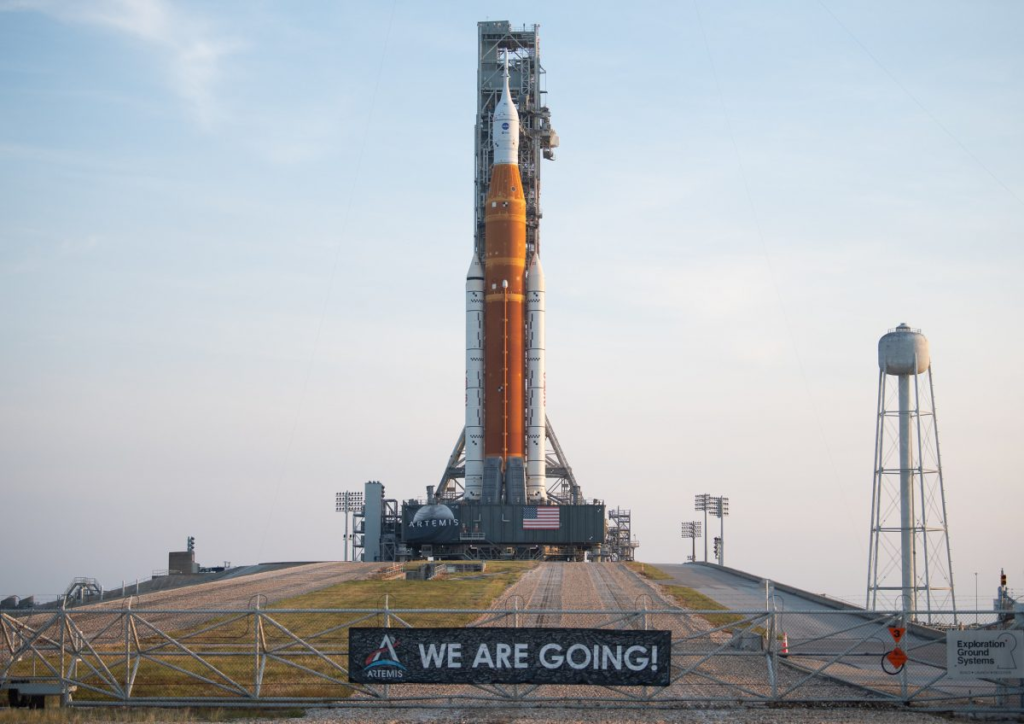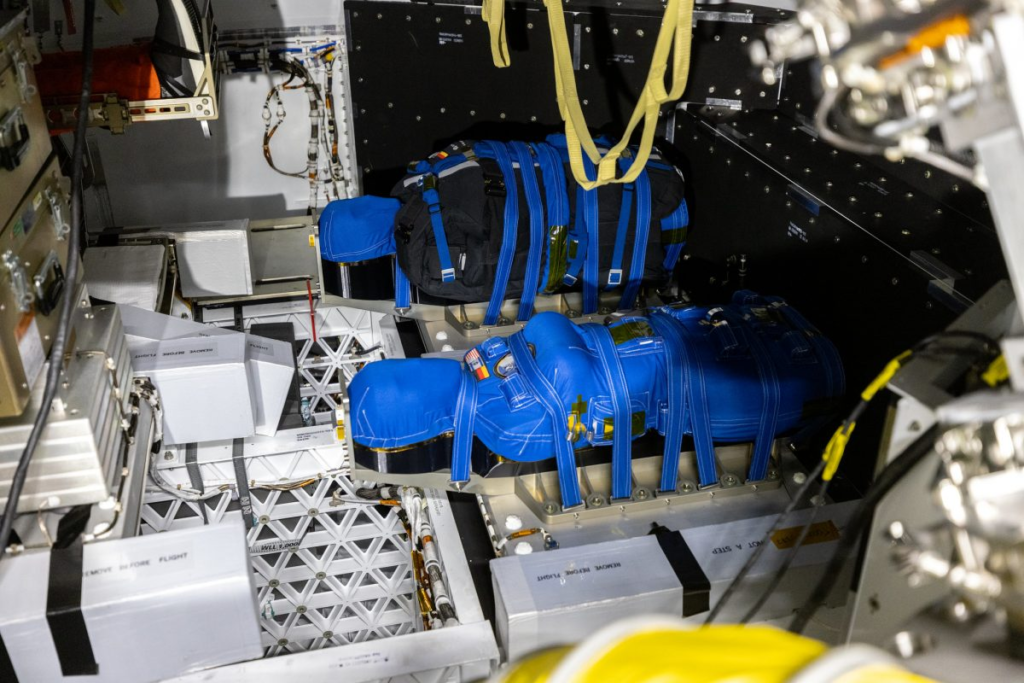
Final Steps Before The First Flight Of SLS
The last few months have been hectic for NASA as the agency has been working towards one of its most ambitious goals in over half a century. Many decades ago the world watched as humans took the first steps on the Moon. Now in 2022, NASA not only wants to return humans to the surface, but set up a more permanent presence that will have a lasting impact on the world and how we access space.
The most recent work has been towards the first flight of the Space Launch System through the Artemis 1 mission. Not only will this test the rocket itself but also the ground systems, Orion capsule, and more. Over the past few days, NASA has kept us updated on some of the final steps and preparations they are making before the big launch.
This mission’s result will significantly impact the future of Artemis and returning humans to the surface. This being said, NASA is confident in the launch vehicle and is only just over a week away from the mission. Here I will go more in-depth into some of the recent progress, when we should expect to see SLS fly, and more.
Recent Updates

Starting a week ago on August 12th, NASA finished some of the final tasks necessary before rolling out the rocket. Specifically, engineers conducted the last integrated test before the Space Launch System (SLS) rocket and Orion spacecraft rolled out to Launch Pad 39B for the launch of the Artemis I flight test. During that week, teams began the second part of the flight termination system (FTS) test. The first part of the test was conducted earlier this year prior to the wet dress rehearsal. For safety purposes, all rockets are required to have a system that the Space Launch Delta 45 can use to terminate the flight if necessary. Following completion of the FTS testing, the Eastern Range requires SLS to launch within a certain timeframe. In order to meet the Aug. 29 launch attempt and backup attempts on Sept. 2 and 5, NASA has received an extension from the Space Launch Delta 45 on the validation of the FTS from 20 to 25 days before the system would need to be retested. The waiver will be valid throughout the Artemis I launch attempts.
After the flight termination system testing was complete, teams completed final closeouts on SLS and Orion before the rollout of the Vehicle Assembly Building, including closing out the core stage and solid rocket boosters and retracting the remaining access platforms. The Orion crew module and launch abort system hatches were closed earlier that week, and Orion was set in the final preparations for roll. In addition, the Matroshka AstroRad Radiation Experiment torsos, Helga and Zohar, outfitted with sensors to measure radiation levels future crew will be exposed to, have joined Commander Campos and are now installed inside the Orion spacecraft. The final payloads, including the agency’s Biology Experiment-1, will be installed once the rocket and spacecraft are at the pad for launch. In this case, two manikins were installed in the passenger seats inside the Artemis I Orion crew module atop the Space Launch System rocket in High Bay 3 of the Vehicle Assembly Building at NASA’s Kennedy Space Center in Florida on Aug. 8th, 2022. As part of the Matroshka AstroRad Radiation Experiment (MARE) investigation, the two manikins – Helga and Zohar – are equipped with radiation detectors, while Zohar also wears a radiation protection vest, to determine the radiation risk on its way to the Moon.
The next update came only a few days later on the 15th. Here, engineers and technicians at NASA’s Kennedy Space Center in Florida completed the final testing and checkouts of the Artemis I Moon rocket ahead of rolling to Launch Pad 39B. The crawler-transporter was readied to roll inside the Vehicle Assembly Building (VAB) and under the Space Launch System rocket and Orion spacecraft later that day. The next day on the 16th, SLS began its journey to the pad. In this case, the Space Launch System rocket and Orion spacecraft for the Artemis I mission were rolled to Launch Complex 39B at the Kennedy Space Center in Florida ahead of launch. At about 10 p.m. EDT the crawler-transporter began the approximately 4-mile, journey from the Vehicle Assembly Building (VAB) to Launch Pad 39B. Once outside the VAB high-bay doors, the Moon rocket made a planned pause allowing the team to reposition the Crew Access Arm before continuing to the launch pad. Finally, around 7:30 a.m. EDT the Space Launch System rocket and Orion spacecraft for the Artemis I mission arrived atop Launch Complex 39B at NASA’s Kennedy Space Center in Florida after a nearly 10-hour journey from the Vehicle Assembly Building. In the coming days, engineers and technicians will configure systems at the pad for launch, which is currently targeted for no earlier than Aug. 29 at 8:33 a.m. (two hour launch window). Teams have worked to refine operations and procedures and have incorporated lessons learned from the wet dress rehearsal test campaign and have updated the launch timeline accordingly.
Before the Artemis I mission launches on its way around the Moon, the launch team at Kennedy Space Center and supporting teams across the country will begin the launch countdown about two days before liftoff. Teams have incorporated lessons learned from the wet dress rehearsal testing and have refined the launch timeline accordingly. The launch countdown contains “L Minus” and “T Minus” times. “L minus” indicates how far away we are from liftoff in hours and minutes. “T minus” time is a sequence of events that are built into the launch countdown. Pauses in the countdown, or “holds,” are built into the countdown to allow the launch team to target a precise launch window, and to provide a cushion of time for certain tasks and procedures without impacting the overall schedule. During planned holds in the countdown process, the countdown clock is intentionally stopped and the T- time also stops. The L- time, however, continues to advance. All of which we are expected to see not long from now.
Artemis I

Now that we know more about the upcoming launch and some of the recent progress NASA has made, we can take a closer look at the mission itself and when we should realistically expect SLS to launch. Artemis I, formerly Exploration Mission-1, will be the first integrated test of NASA’s deep space exploration systems: the Orion spacecraft, Space Launch System (SLS) rocket and the ground systems at Kennedy Space Center in Cape Canaveral, Florida. The first in a series of increasingly complex missions, Artemis I will be an uncrewed flight test that will provide a foundation for human deep space exploration, and demonstrate our commitment and capability to extend human existence to the Moon and beyond.
During this flight, the spacecraft will launch on the most powerful rocket in the world and fly farther than any spacecraft built for humans has ever flown. It will travel 280,000 miles from Earth, thousands of miles beyond the Moon over the course of about a four to six-week mission. Orion will stay in space longer than any ship for astronauts has done without docking to a space station and return home faster and hotter than ever before. All of which is meant to ensure the capabilities of SLS, Orion, etc. and provide a good base for the next missions, Artemis II, III, and beyond. Artemis II will launch humans for the first time but not land on the Moon. Artemis III however is planning on returning humans to the surface. While all of this is very exciting, Artemis I still needs to be a success before moving on to any other mission. In just over a week we should see SLS and Orion blast off from Launch Complex 39B at NASA’s modernized spaceport at Kennedy Space Center in Florida. The SLS rocket is designed for missions beyond low-Earth orbit carrying crew or cargo to the Moon and beyond, and will produce 8.8 million pounds of thrust during liftoff and ascent to loft a vehicle weighing nearly six million pounds to orbit. Propelled by a pair of five segment boosters and four RS-25 engines, the rocket will reach the period of greatest atmospheric force within ninety seconds. After jettisoning the boosters, service module panels, and launch abort system, the core stage engines will shut down and the core stage will separate from the spacecraft. It will proceed to reach the Moon, return to Earth, and attempt to enter the atmosphere in one piece.
Specifically, for its return trip to Earth, Orion will do another close flyby that takes the spacecraft within about 60 miles of the Moon’s surface, the spacecraft will use another precisely timed engine firing of the European-provided service module in conjunction with the Moon’s gravity to accelerate back toward Earth. This maneuver will set the spacecraft on its trajectory back toward Earth to enter our planet’s atmosphere producing temperatures of approximately 5,000 degrees Fahrenheit. While the launch is set for August 29th, it’s very possible we see some delays that push back the maiden launch.
Conclusion
A lot of exciting things are happening right now in the space industry. The first launch of SLS is a great example expected to happen by the end of the month. We will have to wait and see how it progresses and the impact it has on the space industry.
